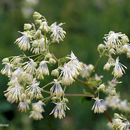Comments
provided by eFloras
Thalictrum dasycarpum is a variable species similar to, and possibly intergrading with, T . pubescens . Glabrous variants of T . dasycarpum have been treated as T . dasycarpum var. hypoglaucum . Glabrous and glandular (stipitate and papillate) forms are found throughout the range of the species and occur together in some populations.
Native Americans used Thalictrum dasycarpum medicinally to reduce fever, cure cramps, as a stimulant for horses, and as a love charm (D. E. Moerman 1986).
- license
- cc-by-nc-sa-3.0
- copyright
- Missouri Botanical Garden, 4344 Shaw Boulevard, St. Louis, MO, 63110 USA
Description
provided by eFloras
Stems erect, stout, 40-150(-200) cm. Leaves chiefly cauline; basal and proximal cauline petiolate, distal cauline leaves sessile or nearly so; petioles and rachises glabrous or occasionally pubescent and/or stipitate-glandular. Leaf blade: basal and proximal cauline 3-5×-ternately compound; leaflets brownish green to dark green or bright green, ovate to cuneate-obovate, apically undivided or 2-3(-5)-lobed, 15-60 × 8-45 mm, length 0.9-2.6 times width, usually leathery with veins prominent abaxially, margins often revolute, lobe margins entire, surfaces abaxially usually pubescent and/or papillose (i.e., with very minute sessile glands). Inflorescences panicles, apically ± acutely pyramidal, many flowered; peduncles and pedicels usually glabrous, rarely pubescent or stipitate-glandular. Flowers usually unisexual, staminate and pistillate on different plants; sepals 4(-6), whitish, lanceolate, 3-5 mm; filaments white to purplish, filiform, scarcely dilated distally, 2-6.5 mm, flexible; anthers 1-3.6(-4) mm, usually strongly apiculate. Achenes numerous, sessile or nearly sessile; stipe 0-1.1 mm; body ovoid to fusiform, 2-4.6 mm, prominently veined, usually pubescent and/or glandular; beak often dehiscent as fruit matures, ± straight, filiform, 1.5-4.7(-6) mm, about as long as achene body.
- license
- cc-by-nc-sa-3.0
- copyright
- Missouri Botanical Garden, 4344 Shaw Boulevard, St. Louis, MO, 63110 USA
Distribution
provided by eFloras
Alta., B.C., Man., Ont., Que., Sask., Yukon; Ala., Ariz., Ark., Colo., Idaho, Ill., Ind., Iowa, Kans., Ky., La., Mich., Minn., Miss., Mo., Mont., Nebr., N.Mex., N.Y., N.Dak., Ohio, Okla., Pa., S.Dak., Tenn., Tex., Utah., Wis., Wyo.
- license
- cc-by-nc-sa-3.0
- copyright
- Missouri Botanical Garden, 4344 Shaw Boulevard, St. Louis, MO, 63110 USA
Flowering/Fruiting
provided by eFloras
Flowering late spring-summer (May-late Jul).
- license
- cc-by-nc-sa-3.0
- copyright
- Missouri Botanical Garden, 4344 Shaw Boulevard, St. Louis, MO, 63110 USA
Habitat
provided by eFloras
Deciduous, riparian woods, damp thickets, swamps, wet meadows, and prairies; 80-2500m.
- license
- cc-by-nc-sa-3.0
- copyright
- Missouri Botanical Garden, 4344 Shaw Boulevard, St. Louis, MO, 63110 USA
Synonym
provided by eFloras
Thalictrum dasycarpum var. hypoglaucum (Rydberg) B. Boivin
- license
- cc-by-nc-sa-3.0
- copyright
- Missouri Botanical Garden, 4344 Shaw Boulevard, St. Louis, MO, 63110 USA
Thalictrum dasycarpum: Brief Summary
provided by wikipedia EN
Thalictrum dasycarpum, known as tall meadow rue and purple meadow-rue, is a species of flowering plant in the buttercup family, Ranunculaceae. It is native to North America.
- license
- cc-by-sa-3.0
- copyright
- Wikipedia authors and editors

